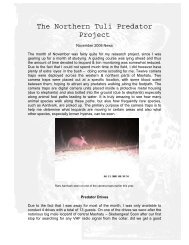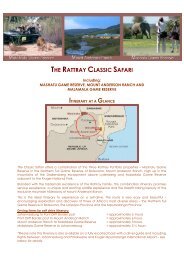central limpopo valley elephant research project - Mashatu Game ...
central limpopo valley elephant research project - Mashatu Game ...
central limpopo valley elephant research project - Mashatu Game ...
Create successful ePaper yourself
Turn your PDF publications into a flip-book with our unique Google optimized e-Paper software.
Elephants are often the victims of snares and in the nine years I have been studying<br />
these amazing creatures we had to shoot several youngsters with snares around<br />
their feet too far gone to save them. Smaller <strong>elephant</strong>s due to their inquisitive nature<br />
sometimes get their trunks caught in these wire snares. The snare will slowly tighten<br />
around the trunk and as it does it cuts deeper and deeper into the trunk eventually<br />
amputating a section of the trunk. The lucky ones are those that only loose a small<br />
portion of the trunk. They will most likely survive. The unlikely ones are those, which<br />
a large portion of the trunk is amputated. As these animals grow up they need to fend<br />
for themselves. It is nearly impossible for the animal to feed itself and even harder to<br />
obtain enough water and over time the animal will die of starvation. On the reserve,<br />
there have been amazing stories of herds taking care of these individuals feeding<br />
them over times of food shortages but eventually the outcome is the same –<br />
starvation!<br />
The Wildlife Department was called as soon as the snared <strong>elephant</strong>s were reported<br />
and confirmed and a veterinarian will be coming out to the reserve early in October to<br />
assist with the snares. Unlike the predators this is not a task we can do ourselves.<br />
The drug used in darting an <strong>elephant</strong> is highly scheduled and only a registered<br />
veterinarian is allowed to dart. It is also a dangerous operation especially when less<br />
than a year old babies are involved. We will monitor the various herds as best we can<br />
(only one herd is collared) until the arrival of the Wildlife veterinarian and hopefully<br />
we can rescue these youngsters from a very painful and most likely fatal experience.<br />
Ivory Drives<br />
During this month a total<br />
of 57 guests participated<br />
in the Ivory Experience<br />
and 8 volunteers partook<br />
in the Research Shadow<br />
Program. A total of 18<br />
different herds were<br />
observed during the<br />
month but the family that<br />
was most often seen was<br />
that of Hestelle with<br />
Charge’s group a close<br />
second. Herds during the<br />
month were mostly seen<br />
either walking or<br />
browsing on the thorny<br />
Acacia trees along the Majale and Limpopo rivers.<br />
On most of the drives we ended up sitting amongst the <strong>elephant</strong>s as they hungrily fed<br />
on the Acacia trees wondering how on earth they manage to eat those thorny twigs.<br />
The babies are growing up fast and as they do they get more adventurous. Bored<br />
with everyone else chomping away on the trees the babies often use the game<br />
viewer as a big toy. An interesting behaviour this month was seen on an afternoon<br />
visit to Cheeky’s herd. We met up with the herd on a very hot afternoon, far from any<br />
2




